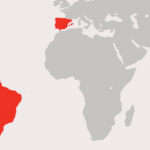Crystal Lagoons – the company related to businessman Fernando Fischmann – has again provided an innovation shock, as it is currently dedicated to the internationalization of two new technologies: non-excavatable crystalline lagoons and the sustainable industrial cooling system.
Within the investigative lines being developed by the company -which invests approximately 30% of its flows in R&D (Research and Development)– are floating crystalline lagoons, that is, water sources which possess high aesthetic and sanitary standards, and are installed and float on bodies of water that are not apt for use, whether as a result of their poor sanitary quality, lack of transparency or deficient aesthetic features.
Intended for recreational uses such as bathing or the practice of sports, the new lagoons are different from the traditional crystal lagoons because the former do not require excavation for their construction and are rapidly assembled on water bodies as a conventional inflatable pool, with a semi-rigid structure. Additionally, “construction only takes a couple of weeks, and the lagoons are highly flexible and do not use any land”, declares Fernando Matte, international director for Crystal Lagoons, when addressing the advantages.
The first project of this type is being developed in Hawaii, at the EWA Beach complex, located in Oahu Island, built alongside Japanese firm Haseko, and which envisages the construction of a three-hectare large lagoon.
However, this is not the only project, and the executive declared that a second lagoon in Asia could soon be built, where “negotiations are already underway for a private project in Malaysia”, he stated.
Matte explains that the market potential for this new venture is very significant. “Worldwide, this technology displays a potential that is even greater than that of excavated crystalline lagoons. Only in the United States, more than 140,000 bodies of water which occupy large extensions exist”, claims Matte. He also adds that, internationally, this figure increases to over 50 million bodies of water.
Cooling technology
After applying the technology for sustainable industrial cooling in thermoelectric power plants, Data Centers, photovoltaic concentration plants and mining plants and at Endesa’s combined cycle thermoelectric plant, San Isidro II, the company then progressed to the commercialization phase. Today, 19 projects are being planned in the U.S., Finland, India, Peru, Saudi Arabia and Chile. “The U.S. will be one of the countries where this technology will be massive, because in that country, the cooling system with natural water flows is already forbidden, due to the enormous damage that it causes and many other countries are following suit”, contends Matte.







